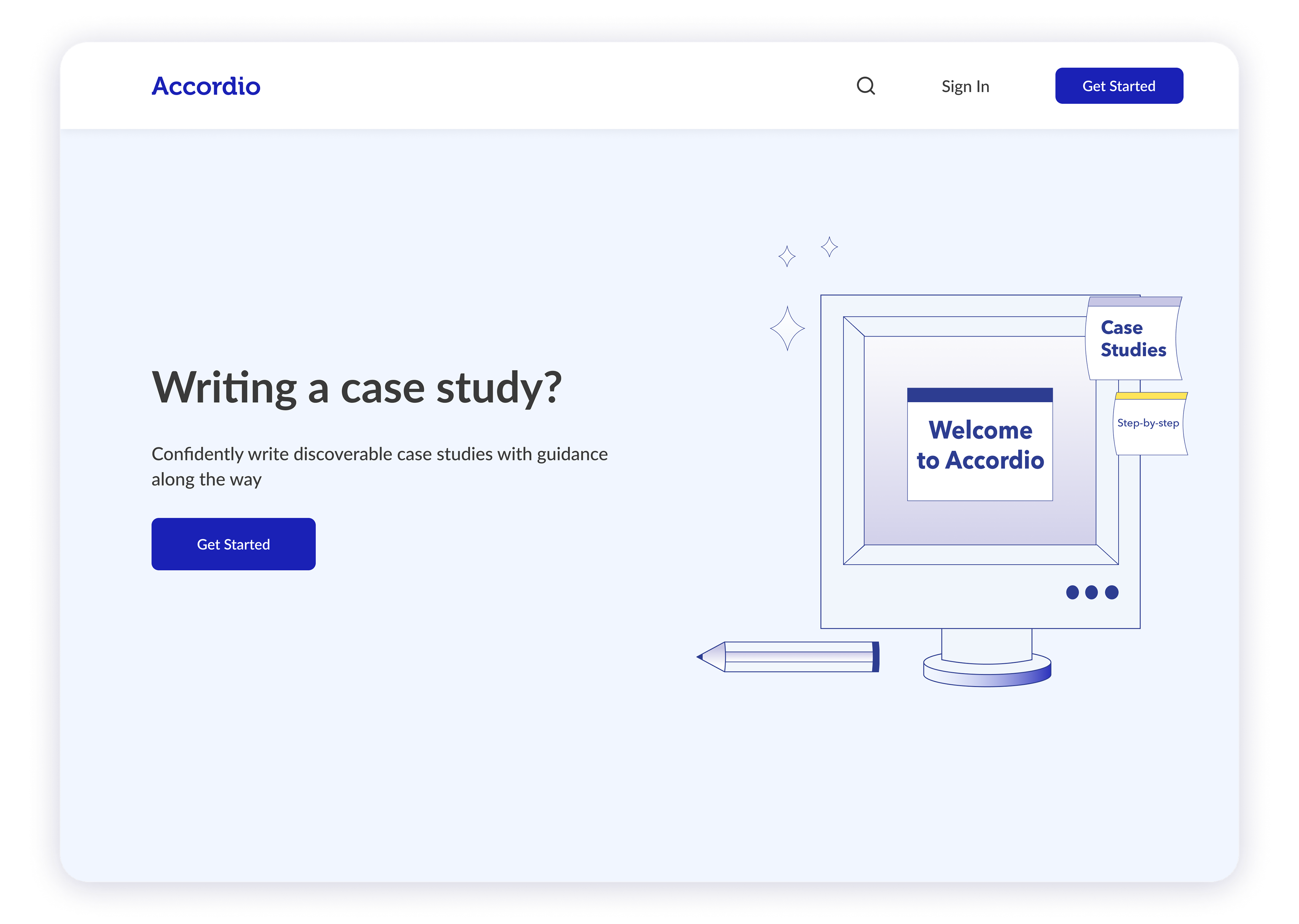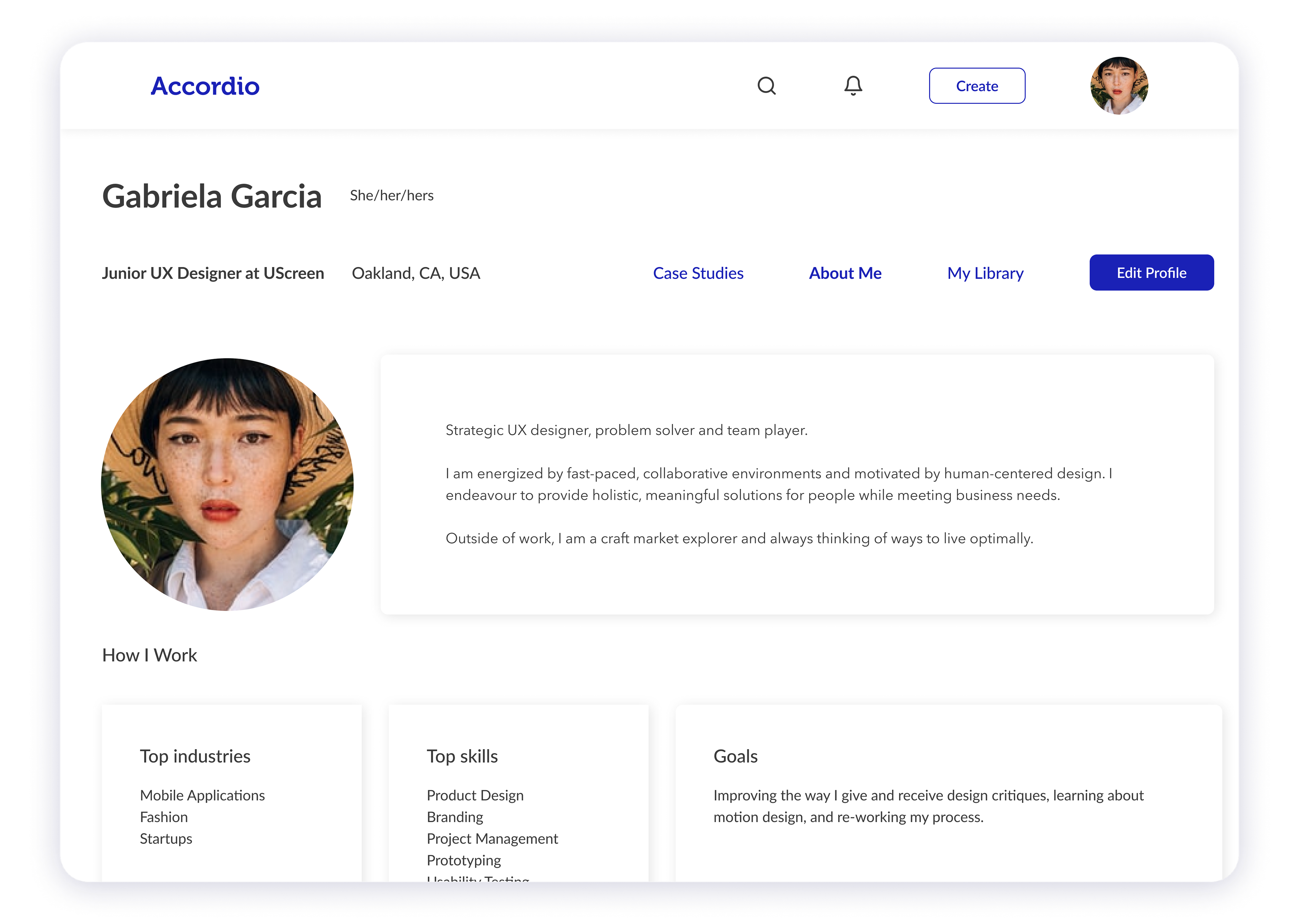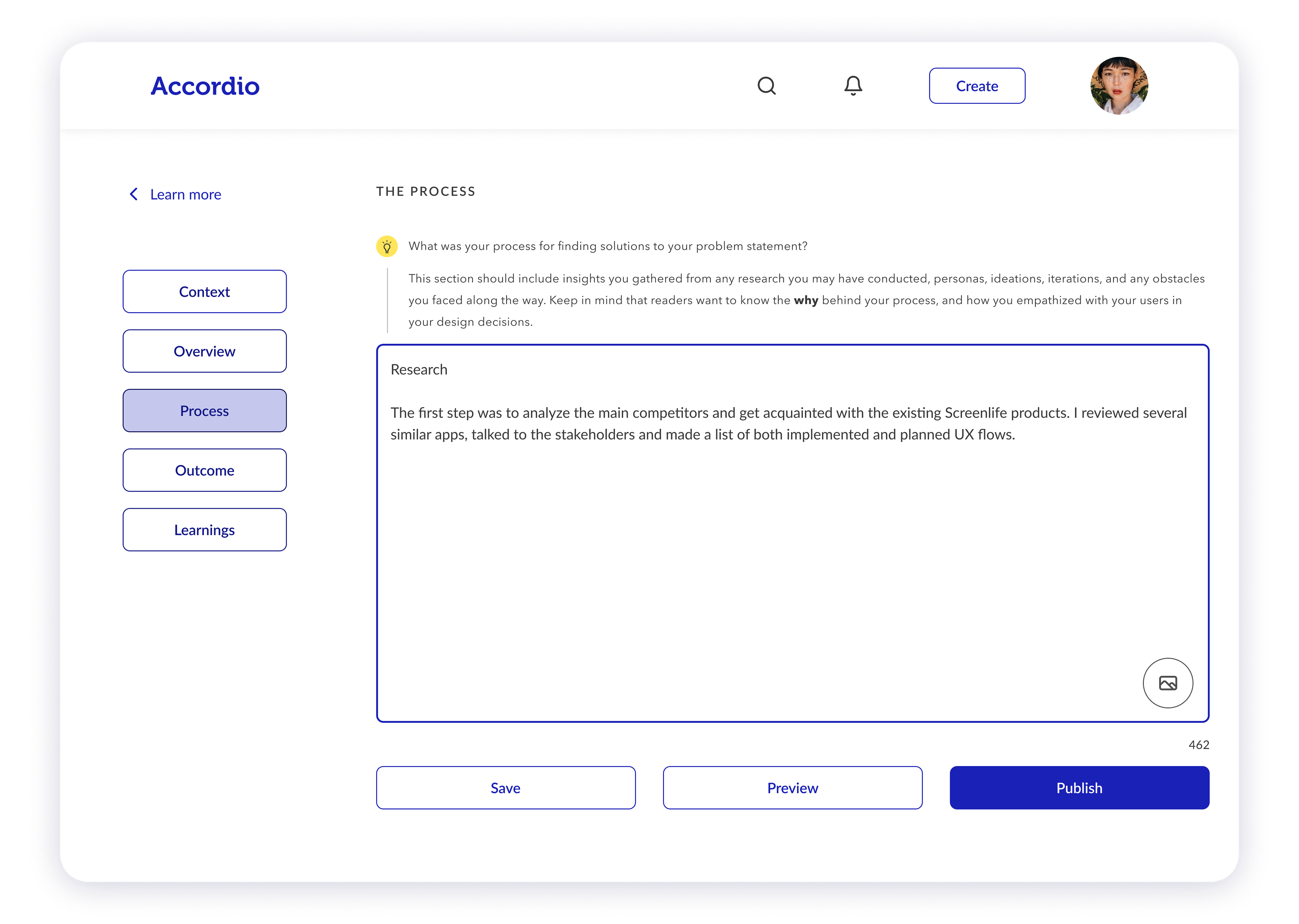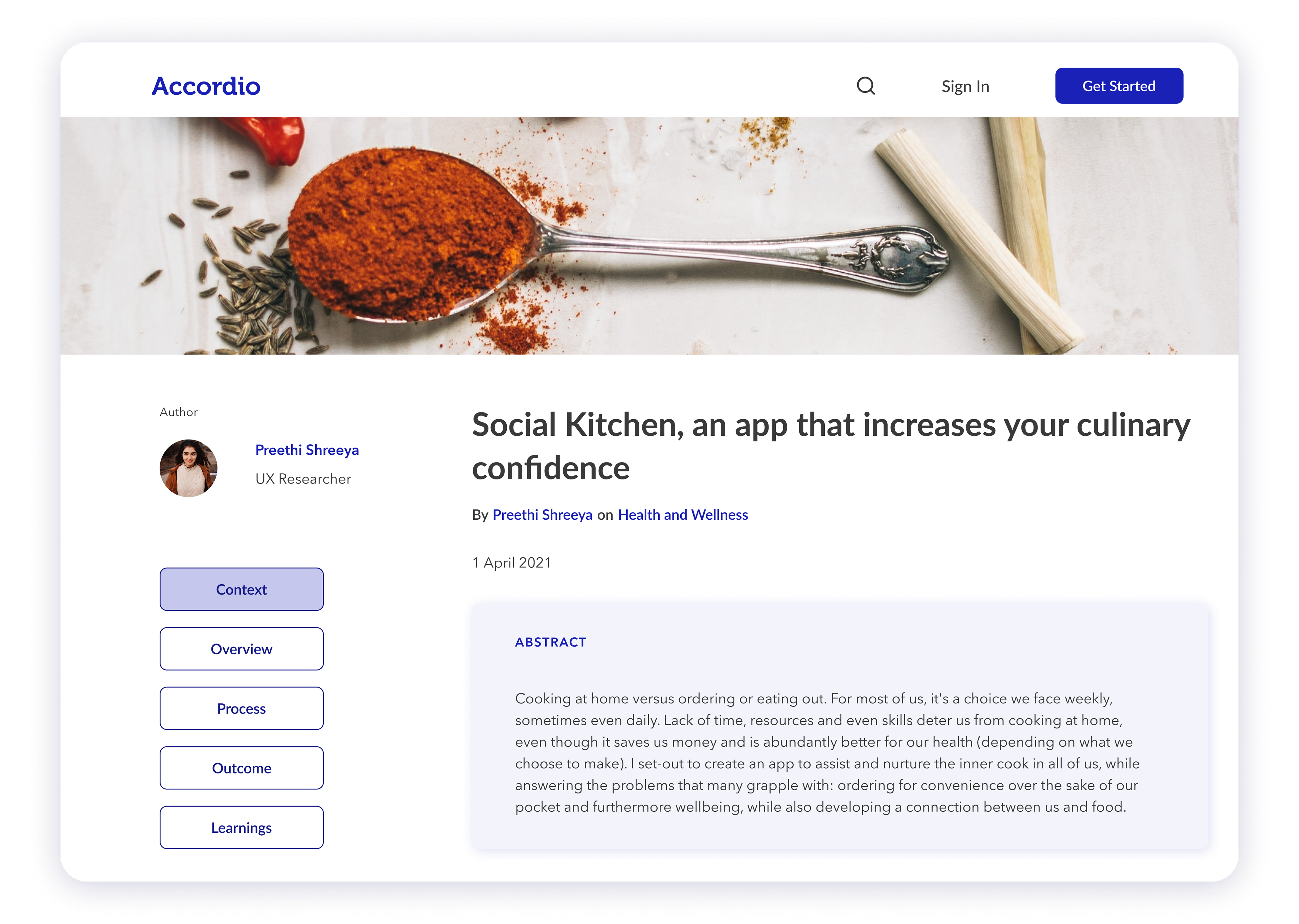Service Design - UX/UI Design
The new Case Study space to showcase your work like never before step by step
My role: Design Team leader, Service Design, UX Research, UI Design
Agency: City of Wind Design
My team: David Pinedo (Product Owner), Vanessa Guerrero (UX/UI), Jenny Van Ann (UI), Joyce Lee (UX), Auden Robertson (Lead Developer)
Tools: Figma, Adobe Illustrator, Notion, Jira, Slack
A community-based platform where product teams can showcase their projects.
Abstract
Accordio was born out of the need to provide a space primarily focused on UX Designers, Service Designers, and CX through which they could create their own case studies and showcase their work. In a field where we find multiple platforms for graphic design and the visualization of a portfolio is favored over its content, we wanted to encourage research writing by UX designers by designing a perfect case study structure. The idea behind Accordio focuses on one hand, on giving users the tools (Guiding Light) step by step of the content they are looking for in a Case Study in a way that makes it easy and quick to create for designers and gives them an efficient portfolio to showcase. And at the same time, to make it accessible and efficient for hiring responsible to reach those designers for possible first contact and a future contract. Through this case study, we will see how Accordio has been devised and brought to life.
Project overview
Problem Statement
Naomi, a visually educated and problem-solving-minded senior designer, needs a way to understand the thinking behind candidates' work while evaluating job applications to feel like she is making informed hiring decisions.
The process
Interviews & Insights obtained
The first step we took was to ask for interviews with both Junior and Senior Designers to provide us with their insights, feedback, and personal experiences about the proposed project. We did this through Slack groups, LinkedIn, and contacts.
During the first round of interviews, the team received comments such as a lack of clarity in the proposal, a lack of credibility in what they were told, there was no order on the first Mid-Fis that were presented to them. This was due to the difficulty that the first iteration provided as we wanted to create a space where designers could upload their research and sell it to third parties in a way that they could profit from their work.
Founders were concerned about the legitimacy and credibility of researchers. Researchers having case studies, their work history, medium articles, and their processes and methods on their user profiles would showcase the legitimacy of their work and speak to their skills and expertise.
Second round
This is when I joined the team and with my fresh points of view, we decided to make adjustments to the project approach. We started from scratch focusing on what Junior Designers experience when they have to create their portfolio as well as Senior Designers and Candidate Seekers when they have to review dozens of case studies.
These are the insights we obtained:
Third round
Finally, once Accordio was finally defined, we conducted new interviews in which we asked Candidate Seekers what a perfect case study would look like for them, what they look for in candidates, and what they think of a platform like Accordio. These were the results:
Crafting personas & Customer Journeys
Junior Designer
As a Junior Designer, I want to structure the perfect Case Study that will land me a job.
Because, I am overwhelmed with the amount of information available.
But/And, I understand that I may write the best process but people may not have the affordance to spend a lot of time reading through it.
Candidate Seeker
As a Candidate Seeker, I want to know the problem statement and the outcome of a case study as soon as I can.
Because my time is valuable and there is never enough of it.
But, I also want to be able to distinguish hight quality candidates and be able to see their thinking processes.
Ideation
During the ideation process and by using Figma, the whole team worked together on sketching the different flows of our project, Accordio. Workshops and collaboration were key for us during the whole project in order to share our best ideas, discuss the multiple features, and what's more important, be on the same page throughout the whole development.
Below you can find the sketches and first Mid-Fis I personally came up with for the project.
Obstacle on the way
The main obstacle I encountered as the Team Leader was first learning how to be an efficient Team Leader for my team. Due to the still ongoing pandemic, the remote work with different countries, and being my first job opportunity made me bring the best out of me and dedicate extra hours at first to properly handle creating the workshops, make sure to have a flowing communication within teams, take care of the project management, and not mix-up time zones.
Another obstacle was the lack of resources at the beginning of the project. This is mainly the limited budget and team members when the project began. Currently, the project is being developed and achieving our expectations.
Outcome
Final Video Prototype (briefed)
The final result is a platform that will help designers create quick but efficient Case Study structures developed after the insights obtained from Senior Hiring Managers and Senior UX Designers. Accordio will provide the tools and the reasons to answer the Why behind our projects while generating a personal portfolio space for designers. On top of that, we offer the possibility to Hiring Managers to dive into a variety of projects to choose from and the possibility to jump among tabs to go directly to the point of those Case Studies.
Illustrations & Process (the website illustrations were made by me)
Main Final Screens




Takeaways
As a team and personally as the team leader, we made the project very personal and took our time to take care of it. These are our takeaways.
1. During the research phase of Accordio, we dedicated too much time to gathering research, insights, and feedback that we didn't realize we should have stopped to start putting it into ideation.
2. We wanted to research perfection from the beginning instead of letting ourselves fail and learn from the process.
3. My biggest challenge was the proper management of the project since we were working remotely from the USA, Australia, and Spain.
Nevertheless, we made it work and now it is under development. We are very proud of our in-house project and we're aware of the future iterations we might have to work on.